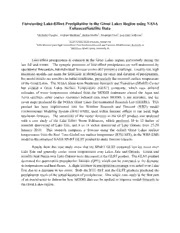
NASA Technical Reports Server (NTRS) 20110008661: Forecasting Lake-Effect Precipitation in the Great Lakes Region Using NASA Enhanced-Satellite Data PDF
Preview NASA Technical Reports Server (NTRS) 20110008661: Forecasting Lake-Effect Precipitation in the Great Lakes Region Using NASA Enhanced-Satellite Data
Forecasting Lake-Effect Precipitation in the Great Lakes Region using NASA EnhancedSatellite Data Michelle Cipullo1, Andrew Molthan2, Jackie Shafer2, Jonathan Case3, and Gary Jedlovec2 1 NorthCarolina State University, Raleigh, NC 2NASA Marshall Space Flight Center/Short-Term Prediction Research and Transition (SPoRT) Center, Huntsville, AL 3ENSCO Inc./SPoRT Center, Huntsville, AL Lake-effect precipitation is common in the Great Lakes region, particularly during the late fall and winter. The synoptic processes of lake-effect precipitation are well understood by operational forecasters, but individual forecast events still present a challenge. Locally run, high resolution models can assist the forecaster in identifying the onset and duration of precipitation, but model results are sensitive to initial conditions, particularly the assumed surface temperature of the Great Lakes. The NASA Short-term Prediction Research and Transition (SPoRT) Center has created a Great Lakes Surface Temperature (GLST) composite, which uses infrared estimates of water temperatures obtained from the MODIS instrument aboard the Aqua and Terra satellites, other coarser resolution infrared data when MODIS is not available, and ice cover maps produced by the NOAA Great Lakes Environmental Research Lab (GLERL). This product has been implemented into the Weather Research and Forecast (WRF) model Environmental Modeling System (WRF-EMS), used within forecast offices to run local, high resolution forecasts. The sensitivity of the model forecast to the GLST product was analyzed with a case study of the Lake Effect Storm Echinacea, which produced 10 to 12 inches of snowfall downwind of Lake Erie, and 8 to 18 inches downwind of Lake Ontario from 27-29 January 2010. This research compares a forecast using the default Great Lakes surface temperatures from the Real Time Global sea surface temperature (RTG SST), in the WRF-EMS model to the enhanced NASA SPoRT GLST product to study forecast impacts. Results from this case study show that the SPoRT GLST contained less ice cover over Lake Erie and generally cooler water temperatures over Lakes Erie and Ontario. Latent and sensible heat fluxes over Lake Ontario were decreased in the GLST product. The GLST product decreased the quantitative precipitation forecast (QPF), which can be correlated to the decrease in temperatures and heat fluxes. A slight increase in precipitation coverage was noted over Lake Erie due to a decrease in ice cover. Both the RTG SST and the GLST products predicted the precipitation south of the actual location of precipitation. This single case study is the first part of an examination to determine how MODIS data can be applied to improve model forecasts in the Great Lakes region.
